The tinted moisturizer cream market is valued at USD 2.2 billion in 2025 and is expected to expand to USD 4.5 billion by 2035, reflecting a CAGR of 7.5%. Market share gain and erosion reveal evolving competition among leading brands, emerging players, and regional segments, highlighting how innovation, marketing, and consumer preferences shape the landscape.
From 2021 through 2025, the market rose from USD 1.5 billion to USD 2.2 billion, incrementally increasing to USD 1.6 billion, 1.7 billion, 1.9 billion, and 2.0 billion. In this initial phase, established beauty brands strengthen their hold by leveraging brand loyalty, wide distribution networks, and product differentiation. Companies introducing multifunctional formulations that combine hydration, SPF, and light coverage capture significant share, while smaller players experience moderate erosion in mature markets.
Between 2026 and 2030, the market grows from USD 2.3 billion to 2.9 billion, climbing through intermediate points of USD 2.5 billion, 2.7 billion, and 2.9 billion. Growth accelerates for brands offering inclusive shades, cruelty-free products, and clean beauty innovations, whereas players unable to adapt face declining market presence. From 2031 to 2035, the market strengthens further, reaching USD 4.5 billion with intermediate markers of USD 3.3 billion, 3.6 billion, 3.9 billion, and 4.1 billion.
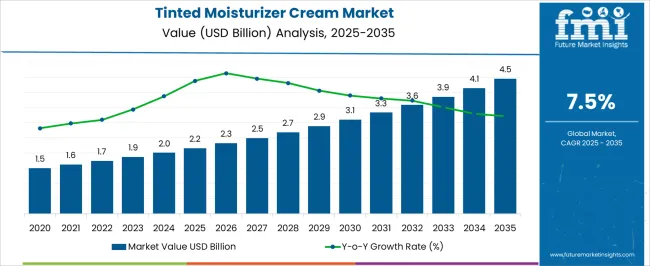
| Metric | Value |
|---|---|
| Tinted Moisturizer Cream Market Estimated Value in (2025 E) | USD 2.2 billion |
| Tinted Moisturizer Cream Market Forecast Value in (2035 F) | USD 4.5 billion |
| Forecast CAGR (2025 to 2035) | 7.5% |
The tinted moisturizer cream market is shaped by interconnected parent markets, each contributing differently to demand and growth. The skincare and cosmetics market holds the largest share at 35%, as consumers increasingly prefer products that combine hydration, sun protection, and light coverage in daily routines. The dermatology and clinical skincare market contributes 25%, with prescription or dermatologist-recommended tinted moisturizers catering to sensitive, acne-prone, or hyperpigmented skin, emphasizing both aesthetics and therapeutic benefits. The luxury and premium beauty market accounts for 20%, targeting high-income consumers seeking specialty formulations, innovative ingredients, and brand prestige. The retail and e-commerce distribution market holds 12%, as product availability through supermarkets, specialty beauty stores, and online platforms directly affects adoption and market penetration. Finally, the travel and hospitality market represents 8%, driven by usage in spas, hotels, and salons where tinted moisturizers complement beauty and wellness services.
The tinted moisturizer cream market is gaining significant traction due to the increasing demand for multifunctional beauty products that offer hydration, coverage, and sun protection in a single application. Consumers are gravitating toward lighter, breathable alternatives to foundation, especially in warmer climates and urban settings where convenience and skincare benefits are prioritized.
The growth is further accelerated by rising skincare awareness, a surge in online beauty tutorials, and the expansion of inclusive shade ranges that cater to diverse skin tones. Brands are also capitalizing on clean beauty trends, offering formulations that are vegan, cruelty-free, and dermatologically tested, broadening appeal among conscious consumers.
Rapid product innovation and hybrid marketing strategies continue to influence purchasing behavior, making tinted moisturizers a staple in modern skincare routines.
The tinted moisturizer cream market is segmented by sun protection, skin type, coverage, age group, packaging type, price range, consumer group, and geographic regions. By sun protection, tinted moisturizer cream market is divided into SPF 25-35, Up to SPF 25, and Above SPF 35. In terms of skin type, tinted moisturizer cream market is classified into Normal, Oily, Dry, Combination, and Sensitive. Based on coverage, tinted moisturizer cream market is segmented into Medium, Full, and Light.
By age group, the tinted moisturizer cream market is segmented into 25-35 Yrs., Below 25 Yrs., 35-45 Yrs., 45-55 Yrs., and Above 55 Yrs.. By packaging type, tinted moisturizer cream market is segmented into Tube, Bottle, and Jar. By price range, tinted moisturizer cream market is segmented into Medium ($25-100), Low (Below $25), and Above $100. By consumer group, tinted moisturizer cream market is segmented into Women and Men. Regionally, the tinted moisturizer cream industry is classified into North America, Latin America, Western Europe, Eastern Europe, Balkan & Baltic Countries, Russia & Belarus, Central Asia, East Asia, South Asia & Pacific, and the Middle East & Africa.
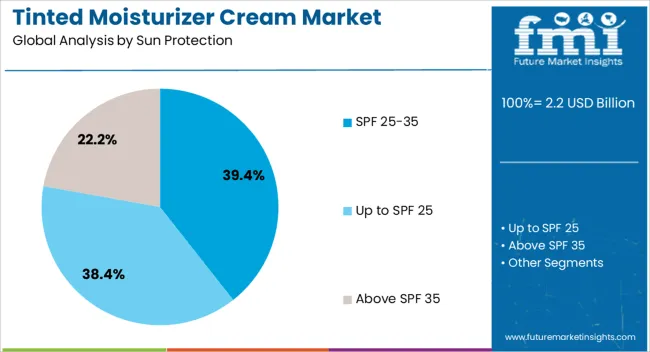
The SPF 25–35 range is projected to dominate the market with a 39.40% share by 2025. This segment’s leadership is driven by its balanced protection level, offering adequate UV defense without compromising on product texture or wearability.
Many consumers prefer SPF 25–35 in daily-use tinted moisturizers as it caters to moderate sun exposure typical of daily commutes and indoor-outdoor transitions. This range is also widely recommended by dermatologists for everyday skincare, which enhances consumer trust and product adoption.
Brands targeting urban and working women often prioritize this SPF level, aligning it with lightweight formulations suited for office or casual environments.
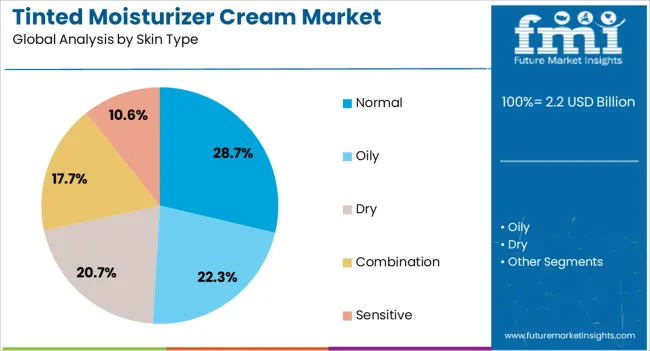
Normal skin type is expected to lead with a 28.70% market share by 2025 among skin type preferences. Its dominance stems from its broader compatibility with a wide range of tinted moisturizer formulations, requiring less customization or targeted ingredients.
Manufacturers frequently test and launch new tinted moisturizer lines on normal skin benchmarks due to its stability, which streamlines product development and market entry.
Additionally, marketing efforts often default to normal skin in visual campaigns, subtly influencing consumer perception and driving sales in this category.
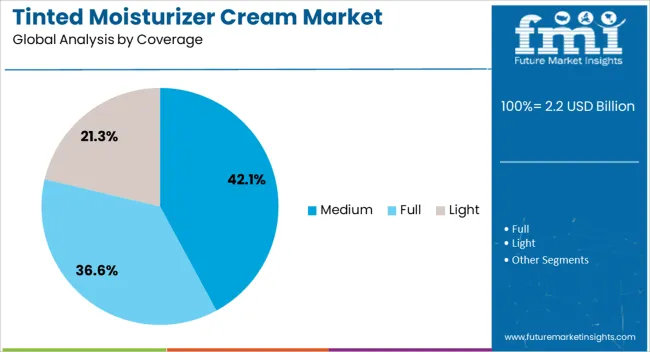
Medium coverage is forecast to command 42.10% of the tinted moisturizer cream market share by 2025, making it the leading coverage level. This segment balances the desire for natural aesthetics with the need to conceal blemishes, discoloration, or uneven skin tone.
Consumers value medium coverage for its ability to even out complexion without the heaviness of full foundation, making it a daily essential. This preference is especially pronounced in professional and social settings where polished yet effortless looks are favored.
The rise of hybrid cosmetics, blurring the line between skincare and makeup, continues to reinforce demand for medium coverage tinted moisturizers.
The tinted moisturizer cream market is growing as consumers increasingly seek products that combine skincare benefits with light coverage. Demand is driven by the desire for natural-looking, multifunctional cosmetics that offer hydration, SPF protection, and subtle tint in a single formulation. Challenges include formulation stability, shade matching for diverse skin tones, and regulatory compliance across regions.
Opportunities exist in lightweight, fast-absorbing textures, anti-aging additives, and customizable shades. Trends highlight multifunctional ingredients, convenient packaging formats, and digital try-on tools. Suppliers providing high-quality formulations, shade variety, and reliable distribution channels are best positioned to capture growing adoption in both mass-market and premium cosmetic segments.
Consumers are increasingly looking for cosmetics that simplify their daily routines by combining hydration, sun protection, and light coverage. The tinted moisturizer cream market benefits from this demand as products provide a natural finish while offering skincare benefits such as moisturizing, antioxidant protection, and SPF defense. Busy urban consumers and working professionals prefer these products for their convenience and quick application. The growing popularity of “no-makeup” makeup looks in social media and influencer campaigns has further amplified adoption. Dermatologists and beauty advisors recommend tinted moisturizers for sensitive skin as they provide a lighter alternative to foundation. This rising awareness, combined with product innovation in textures and shade ranges, continues to drive market growth globally.
Constraints in the tinted moisturizer cream market arise from the high cost of multifunctional ingredients, including SPF filters, antioxidants, and hydrating compounds. Stability of formulations across different climates and packaging types can be challenging, particularly when incorporating natural extracts or pigments. Regulatory compliance is required for claims such as SPF protection, hypoallergenic labeling, or anti-aging benefits, which vary across regions. Color matching and consistency across batches demand rigorous quality control and testing. Supply chain disruptions in raw materials, such as oils, emollients, and natural extracts, can affect production timelines. Buyers often prefer suppliers who offer stable formulations, shade range customization, and verified certifications to ensure consistent product quality and regulatory adherence.
Brands are exploring tinted moisturizers with anti-aging peptides, vitamins, and hyaluronic acid to appeal to skincare-conscious consumers. Expanding shade ranges for diverse skin tones opens new market segments in regions with multicultural populations. Compact, travel-friendly packaging and convenient dispensers enhance user experience and repeat purchase rates. Digital tools such as virtual try-on apps and personalized shade matching services are emerging as key drivers of consumer engagement. Partnerships with dermatologists, beauty influencers, and cosmetic retailers further amplify awareness. Suppliers offering flexible formulations, effective ingredient delivery, and customizable shade options are positioned to capture premium and mass-market opportunities.
Digital engagement, including augmented reality-based shade matching and virtual try-on platforms, is increasingly influencing purchase decisions. Packaging innovations such as airless pumps, tubes, and compact designs improve shelf life, user convenience, and product hygiene. Incorporation of novel ingredients for skin health, improved texture, and matte or dewy finishes is shaping product development. Collaboration between cosmetic chemists, dermatologists, and retail partners is enhancing product performance and consumer trust.
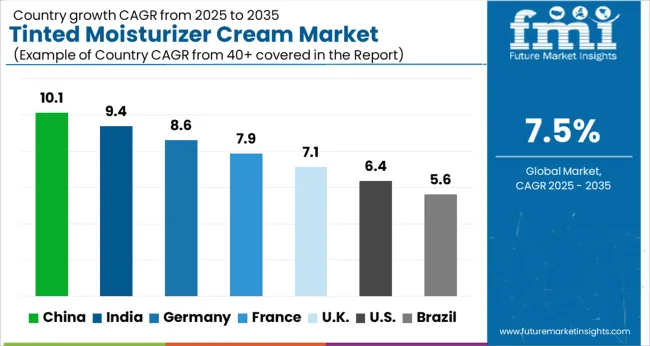
| Country | CAGR |
|---|---|
| China | 10.1% |
| India | 9.4% |
| Germany | 8.6% |
| France | 7.9% |
| UK | 7.1% |
| USA | 6.4% |
| Brazil | 5.6% |
The global tinted moisturizer cream market is projected to grow at a CAGR of 7.5% from 2025 to 2035. China leads at 10.1%, followed by India at 9.4%, France at 7.9%, the UK at 7.1%, and the USA at 6.4%. Growth is driven by rising urbanization, increasing disposable incomes, and a growing preference for multifunctional skincare-makeup hybrid products. E-commerce, social media campaigns, and influencer marketing accelerate adoption, while domestic and international brands innovate formulations for skin tone, climate, and consumer preferences. Asia, particularly China and India, demonstrates rapid expansion, whereas Europe and North America emphasize premium formulations, convenience, and product accessibility through diversified retail channels. The analysis spans over 40+ countries, with the leading markets shown below.
Demand for tinted moisturizer cream in China is growing at a CAGR of 10.1% from 2025 to 2035. Growth is driven by rising urbanization, increasing disposable incomes, and expanding awareness of skincare and cosmetic routines. Consumers are increasingly preferring multifunctional products that provide hydration, sun protection, and light coverage in one solution. E-commerce platforms, live-streaming, and social media campaigns are accelerating adoption, particularly among younger demographics. Domestic brands are innovating with formulations tailored to different skin types and tones, while international players continue to strengthen their presence through collaborations and influencer-driven marketing. The beauty and personal care retail ecosystem, including specialty stores and online marketplaces, ensures wide accessibility, boosting market penetration.
The tinted moisturizer cream market in India is expected to expand at a CAGR of 9.4% from 2025 to 2035, supported by rising urban populations, expanding middle-class income, and increased beauty awareness. Consumers are seeking products that provide lightweight coverage, hydration, and UV protection for everyday use. Online retail platforms and beauty influencers are boosting product visibility and accessibility. Domestic manufacturers are innovating affordable, high-performance tinted moisturizers tailored to Indian skin tones, while global brands are introducing premium ranges targeting affluent consumers. Growing participation in corporate and social events, along with an emphasis on self-care routines, further drives adoption. Retail expansion across malls, pharmacies, and specialty cosmetic stores enhances market reach.
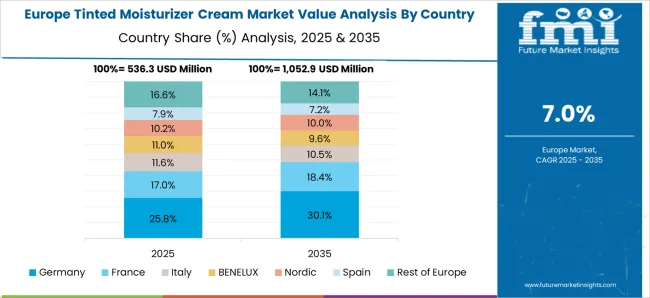
Sales of tinted moisturizer cream are projected to expand at a CAGR of 7.9% from 2025 to 2035. Consumers are increasingly prioritizing skincare-makeup hybrid products that offer hydration, SPF protection, and natural coverage. French cosmetic brands are innovating with premium formulations emphasizing texture, fragrance, and skin compatibility. E-commerce platforms and luxury beauty retailers facilitate easy access to both domestic and international brands. Awareness of multifunctional and quick-application products is increasing among working professionals and urban women. Seasonal campaigns and marketing by beauty influencers further drive consumer interest. The market is also influenced by skincare trends emphasizing facial protection against UV exposure and environmental factors.
The UK market is expected to grow at a CAGR of 7.1% from 2025 to 2035, led by consumers’ increasing preference for natural-looking coverage and multifunctional skincare products. Products combining hydration, sun protection, and lightweight tint are driving adoption among working professionals and urban millennials. Retailers are expanding offerings in drugstores, specialty beauty stores, and e-commerce platforms, improving accessibility. Influencer collaborations and digital marketing campaigns are encouraging trial and repeat purchases. Demand for products suitable for varying skin tones and climates is shaping product portfolios. Premium brands emphasizing texture, finish, and skincare benefits are capturing attention, while mid-range offerings provide affordable alternatives.
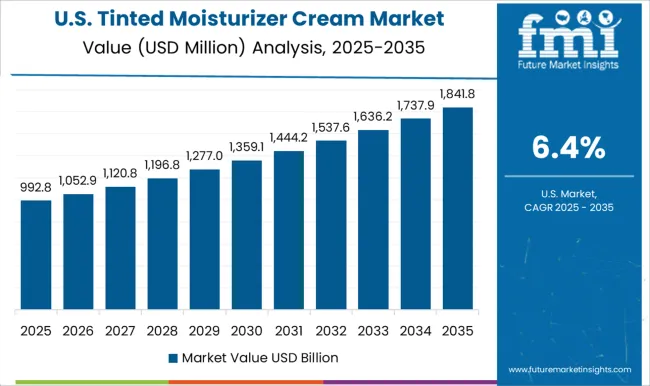
The USA market is projected to grow at a CAGR of 6.4% from 2025 to 2035. Growth is supported by consumers seeking multifunctional products that combine lightweight coverage, hydration, and sun protection. Urban populations and working professionals are increasingly adopting tinted moisturizers for daily routines. Digital marketing, e-commerce platforms, and social media influencers are expanding awareness and boosting trial among younger demographics. Both domestic and international cosmetic brands are introducing innovative formulations tailored to varying skin tones, sensitivities, and climates. Convenience, packaging innovation, and texture preferences also influence purchasing decisions. Retail channels including specialty stores, department stores, and online marketplaces are driving availability and adoption.
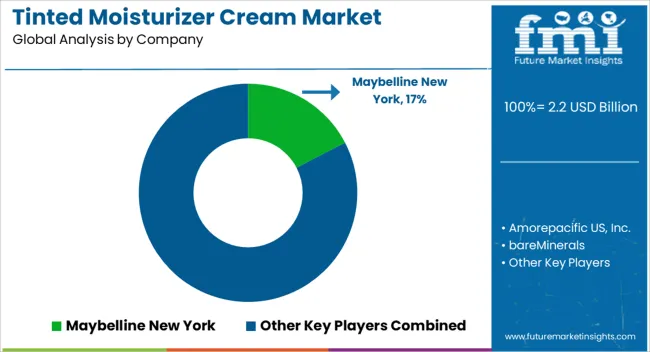
Competition in the tinted moisturizer cream market is shaped by formulation innovation, skin tone inclusivity, and brand recognition. Maybelline New York leads through mass-market accessibility, lightweight textures, and wide shade ranges that suit diverse consumers. bareMinerals and Bobbi Brown Professional Cosmetics compete with clean, mineral-based formulations, emphasizing buildable coverage and skin-nourishing ingredients. Amorepacific US, Inc. leverages K-beauty expertise to deliver hydrating, SPF-infused creams with dewy finishes. Premium players like Comprof Milano S.r.l. and Dr Irena Eris target anti-aging benefits, botanical extracts, and high SPF protection. Faces Canada, Urban Decay, and ZARA differentiate with trend-focused formulations, ease of blending, and visually appealing packaging. Dolce & Gabbana positions as a luxury option with rich textures, long-lasting hydration, and elegant presentation. Strategies emphasize multi-functionality and consumer-centric innovation.
Products are marketed as combining foundation, moisturizer, and sun protection in a single application. Shade expansions and SPF integration are highlighted to meet diverse skin types and climates. Lightweight formulations, hydration benefits, and dermatologically tested ingredients are used to enhance consumer trust. Limited-edition launches, influencer collaborations, and social media campaigns are deployed to capture younger, fashion-conscious audiences. Retail and e-commerce channels are leveraged for rapid distribution and visibility. Brand portfolios are expanded with complementary primers, serums, and setting powders to encourage repeat use and ecosystem adoption. Product brochure content is precise and informative. Specifications highlight SPF rating, coverage type, finish (matte, dewy, natural), hydration, and skin compatibility. Packaging formats include tubes, compacts, and hygienic pump bottles. Ingredient benefits, hypoallergenic claims, and dermatological testing are described. Shade guides, usage instructions, and application techniques are detailed to ensure correct selection and optimal results. Multi-purpose utility is emphasized, including pairing with primers or setting products for professional or everyday use.
| Item | Value |
|---|---|
| Quantitative Units | USD 2.2 Billion |
| Sun Protection | SPF 25-35, Up to SPF 25, and Above SPF 35 |
| Skin Type | Normal, Oily, Dry, Combination, and Sensitive |
| Coverage | Medium, Full, and Light |
| Age Group | 25-35 Yrs., Below 25 Yrs., 35-45 Yrs., 45-55 Yrs., and Above 55 Yrs. |
| Packaging Type | Tube, Bottle, and Jar |
| Price Range | Medium ($25-100), Low (Below $25), and Above $100 |
| Consumer Group | Women and Men |
| Regions Covered | North America, Europe, Asia-Pacific, Latin America, Middle East & Africa |
| Country Covered | United States, Canada, Germany, France, United Kingdom, China, Japan, India, Brazil, South Africa |
| Key Companies Profiled | Maybelline New York, Amorepacific US, Inc., bareMinerals, Bobbi Brown Professional Cosmetics, Inc., Comprof Milano S.r.l, Dolce Gabbana, Dr Irena Eris, Faces Canada, Urban Decay, and ZARA |
| Additional Attributes | Dollar sales by product type (liquid, cream, gel), skin benefit (hydration, SPF protection, anti-aging), and application (daily skincare, cosmetic coverage, sun protection). Demand dynamics are driven by rising consumer preference for multitasking products, increased awareness of skincare, and digital beauty influence. Regional trends indicate strong growth in North America, Europe, and Asia-Pacific, supported by expanding cosmetic retail channels, e-commerce penetration, and growing interest in clean and dermatologically tested formulations. |
The global tinted moisturizer cream market is estimated to be valued at USD 2.2 billion in 2025.
The market size for the tinted moisturizer cream market is projected to reach USD 4.5 billion by 2035.
The tinted moisturizer cream market is expected to grow at a 7.5% CAGR between 2025 and 2035.
The key product types in the tinted moisturizer cream market are SPF 25-35, up to SPF 25 and above SPF 35.
In terms of skin type, normal segment to command 28.7% share in the tinted moisturizer cream market in 2025.






Full Research Suite comprises of:
Market outlook & trends analysis
Interviews & case studies
Strategic recommendations
Vendor profiles & capabilities analysis
5-year forecasts
8 regions and 60+ country-level data splits
Market segment data splits
12 months of continuous data updates
DELIVERED AS:
PDF EXCEL ONLINE
Tinted Cosmetics Market Size and Share Forecast Outlook 2025 to 2035
Tinted Sunscreen Market Size and Share Forecast Outlook 2025 to 2035
Tinted Glass Market Growth - Trends & Forecast 2025 to 2035
Peptide-Infused Tinted Moisturizers Market Size and Share Forecast Outlook 2025 to 2035
SPF Moisturizers Market Analysis - Size and Share Forecast Outlook 2025 to 2035
Argan Oil Moisturizers Market Analysis - Size, Share, and Forecast Outlook 2025 to 2035
Market Share Insights of Unscented Moisturizer Providers
Hemp Seed Oil Moisturizers Market Analysis - Size and Share Forecast Outlook 2025 to 2035
Ceramide-Infused Moisturizers Market Analysis - Size and Share Forecast Outlook 2025 to 2035
Cream of Tartar Market Size and Share Forecast Outlook 2025 to 2035
Cream Separator Market Size and Share Forecast Outlook 2025 to 2035
Cream Cheese Market Analysis – Size, Share, and Forecast 2025 to 2035
BB Cream Market Analysis by Skin Type, SPF Type, End Uses, Sales Channel and Region through 2025 to 2035
Ice Cream Coating Market Size and Share Forecast Outlook 2025 to 2035
Ice-cream Premix and Stabilizers Market Size and Share Forecast Outlook 2025 to 2035
Ice Cream Equipment Market Size and Share Forecast Outlook 2025 to 2035
Analysis and Growth Projections for Ice Cream and Frozen Dessert Market from 2025 to 2035
Ice Cream Packaging Market - Outlook 2025 to 2035
Ice Cream Processing Equipment Market Growth - Trends, Demand & Innovations 2025 to 2035
Ice Cream Service Supplies Market - Premium Serving Essentials 2025 to 2035

Thank you!
You will receive an email from our Business Development Manager. Please be sure to check your SPAM/JUNK folder too.
Chat With
MaRIA